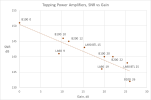Marked down because no trigger cable is included.
I think, he has heard, what he has expected to hear.
For him, feedback is an ugly thing, because he didn’t understand, that it makes an amp „quicker“ and not „slower“ and also better in rising times, bandwith and the whole time domain.
His expectation became reality in his brain, because the differences in sound are tiny, of course.
So, for him, the B200 sounded slow, muffled, sluggish……
It is, like Bruno sayed: They only read the Maty Otala Articles in 1973 half!
Imagine what he would have heared, if he had done a proper unbiased Double Blind Test with B200 and the top Class-D-Constructions of Bruno Putzeys or the Benchmark AHB2 included…..
Yes, also the Benchmark is as extremely good as it is, BECAUSE of Feedback and not DESPITE Feedback.
And the B200 are even more than 40% more powerful, more linear and 2 x „cleaner“ in the high frequency range,
because time stood not still and the Benchmark Construction has begun in 2008.





